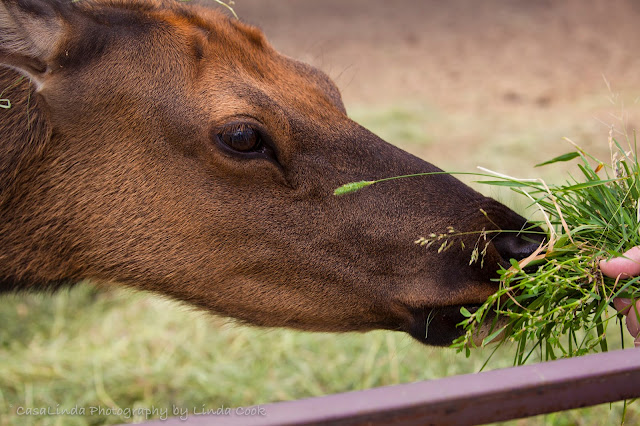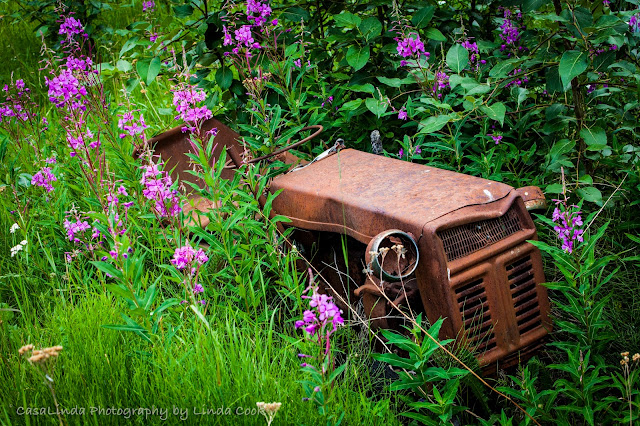Rob asked me on our drive to Lake Louise, "What's there to see?"
My response was, "I don't know."
To the best of my recollection, Rob replied, "You don't know if there's anything there? Why are we going?"
"To see the other Lake Louise!"
To me, it didn't matter if absolutely nothing was there. It only mattered that we see a place where we've never been. But, there was something there. There were a couple of lodges and we stopped in at The Point Lodge to just check it out. We met a nice gal who was there covering for the owners who had gone 'into town' (which meant they were in Anchorage probably picking up supplies). Turns out this woman lives up the road with her husband—off the grid. She was originally from Mendocino, California, and had come up to Alaska a few decades ago to get away from a man. Then she met her husband and stayed in Alaska. They have a small cabin with a generator for electricity and an outhouse (yes, even in the dead of winter. Brrrr!). I don't recall if they had running water but, no matter, they have all they need. She loves her simple life.
The Point Lodge is/was for sale. It looked to be very nice accommodations for those who want to come fish or simply boat on the lake. What captured my attention, being the animal lover I am, were the many Tree Swallows flitting around, swooping up and down over the lake and delivering the caught insects to the many birdhouses adorning the property. They obviously had lots of hatchlings to feed. What amazed me were the number of mayflies they could catch in their beaks in one outing. And that they let me get pretty close to them with my camera.
Lake Louise was the place that first introduced me to Fireweed, a lovely wildflower that grows profusely in the north. Its grows on a long stem, some growing as tall as eight feet, its leaves look similar to day lily leaves only a little narrower and more of them. At the top of the stems, the flowers bloom from bottom up, dazzling you with bright magenta flowers. People drink its nectar, eat its petals, make jellies and honeys, and scent soaps and candles with its perfume. It is as versatile as it is beautiful.
This sweet fella was our welcoming-committee-of-one when we arrived at the banks of Lake Louise:
Lake Louise with Fireweed in the foreground:
As the blooms die, they become long, dark magenta, to nearly red, seed pods.
A Tree Swallow making a lunch delivery to the brood:
The clouds in Alaska are proportional to the size of the state itself:
Just look at the number of mayflies in this bird's mouth! You'd think some of these insects would have flown away while he/she caught others. Nature is amazing.
I love bees! And I have many flower photos featuring bees hard at work, so this is just the first of many:
And a panorama of Lake Louise. Be sure to click on it to see it as large as your monitor will allow.
Last October while Rob and I were on our way to Quartzsite for the winter, I was texting with my sister, Pamela, and suggested she think about joining us for a week or two in Alaska. I don't believe she had to think much about it at all. I think it was a done deal, a no-brainer. But a week or two wasn't going to cut it for her, though. She made plans to come for a month!
The last time my sister and I lived under the same roof was when we were teenagers. I know all three of us wondered how it would work out living in no more than about 310 square feet of motorhome. Would we be at each other's throats within days? I'm sure Rob wondered about it more than Pamela and I. One never knows for sure, but I was fairly confident it would work out. All three of us are easy-going people. And work out it did.
It was truly wonderful to have my sister with me. I don't think I would have seen or done as much in Alaska if it hadn't been for her company. Rob just doesn't want to go do a lot of site seeing because most of it requires standing and walking and that's just not as easy for him as it used to be. But I don't enjoy doing it alone. Aside from that, this trip gave Pamela and me a chance to get reacquainted after all the years of raising kids and working full time. Most times I'd only see her on Thanksgiving and/or Christmas. She is an RN and some years she had to work the holidays. Our work schedules were usually in conflict. I worked regular business hours and she worked evenings and often on the weekends. So this trip was a welcome and companionable respite for the two of us.
This was our first outing together just the day after Pamela's arrival in Anchorage. The Reindeer Farm:
Pamela enjoying these gentle animals. Do you know the difference between Reindeer and Caribou? Caribou is wild, Reindeer is captive. That's it. No other difference.
Meet Dolly the Bison. You can tell she is a well cared for and well fed member of the Reindeer Farm. Just look at that beautiful coat.
If you look closely into Dolly's eye, you can see all of us tourists standing around looking at her.
They have a good sized herd of Elk at the Reindeer Farm as well.
And they love the sweet grasses hand fed to them.
This one is saying to Pamela, "Where's my grass?"
The Reindeer Farm also offers horseback trail rides. A group had just returned as Pamela and I were ready to leave. We had to visit with these magnificent animals, too!
Just beautiful.
On the way back from the Reindeer Farm, Pamela and I stopped at a roadside property that looked to be nothing more than an automobile junkyard. There was even a carnival ride—a small ferris wheel—and an old farming tractor rusting in the grass. To me, it looked like a photographic boon. Being that the skies were cloudy and gray, it made all the colors bright and vibrant. Although I have many I love, these turned out to be some of my favorite photos from the whole trip:
Of course there's Fireweed! It grows everywhere.
A day trip was in order and we decided to drive to the Kenai Peninsula to Seward. We visited the Alaska Sealife Center. I wish we'd had the time to go to other areas on the Kenai but, alas, we could only do so much.
This fellow looks like he's only missing a bowler hat and a bow tie:
On the way back from Seward we stopped along the highway at Falls Creek—a lovely waterfall you can glimpse from the road if you're looking just at the right moment.
Stayed tuned for Part III. It will be about a very colorful place.

























































